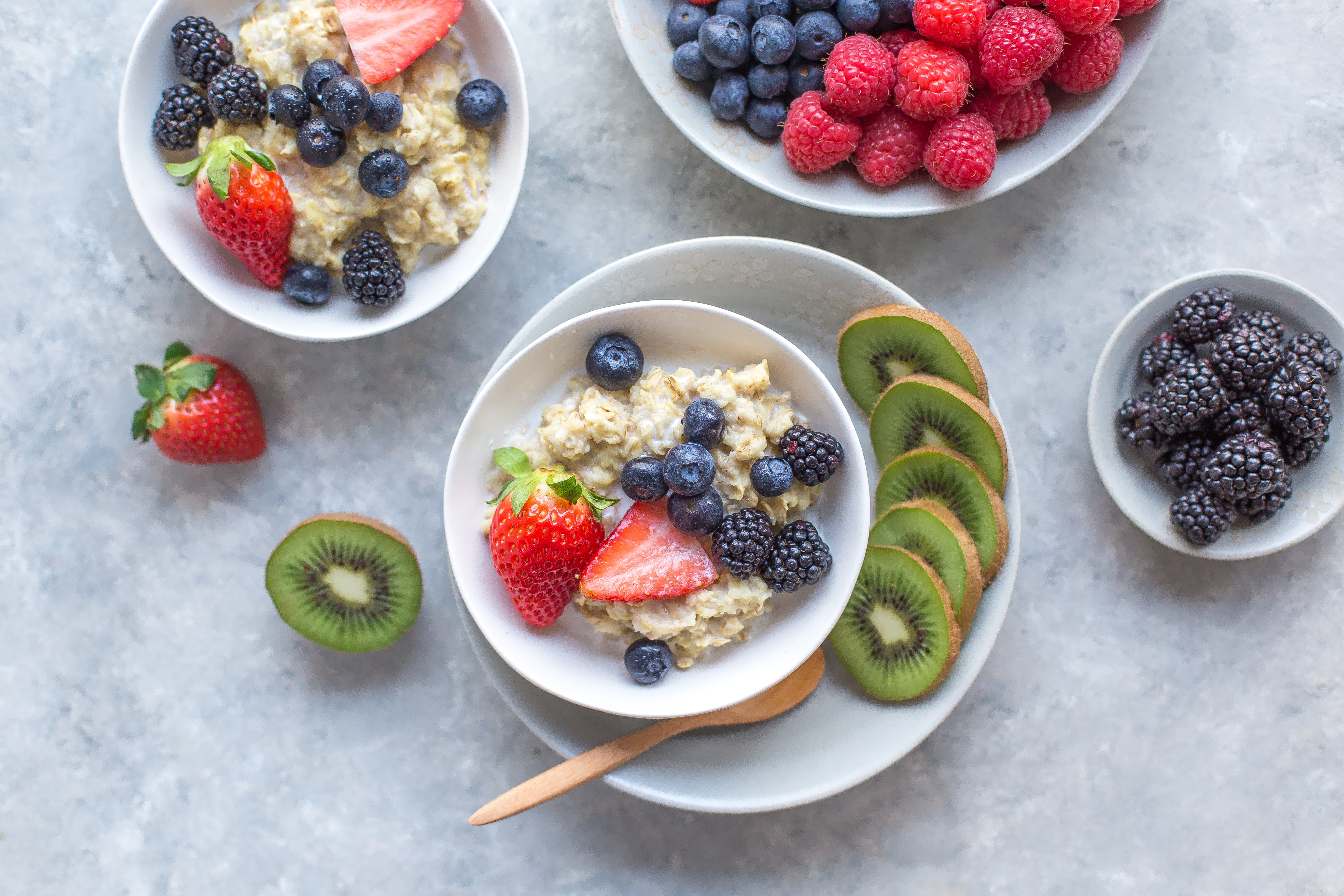
Oats and fruit are good sources of fiber (Photo by Melissa Belanger on Unsplash)
Most people know that eating high-fiber foods promotes regular bowel movements. And you may have heard that dietary fiber can help reduce high cholesterol and blood glucose levels.
According to the Food and Nutrition Board of the National Academy of Sciences, which presents the Dietary Reference Intakes, “The recommended intake for total fiber for adults 50 years and younger is set at 38 grams for men and 25 grams for women, while for men and women over 50 it is 30 and 21 grams per day, respectively, due to decreased food consumption.”
But there are many types of fiber with unique properties and health benefits, so eating more fiber is not a one-size-fits-all solution. You must understand how each type of fiber works in the body in order to choose the right foods to achieve your health goals.
TWO TYPES OF FIBER:
- Dietary fiber is a natural part of plant cell walls that provides structure to grains, legumes, fruits and vegetables. It’s an indigestible form of carbohydrate that can either slow or speed transit time of food waste through the gastrointestinal system, depending on its solubility and viscosity.
- Functional fiber is extracted and isolated from indigestible carbohydrates and added back to foods for a specific, evidence-based health benefit, beyond what the food provides.
CLASSIFY FIBER BY THESE PROPERTIES:
Fermentability: The degree to which indigestible plant fibers can be fermented by bacteria in the colon. Fermentation produces short-chain fatty acids (SCFA), butyrate, acetate and propionate, that make the colon environment more acidic and inhibit the growth of polyps. SCFA provide fuel for colon cells and increase levels of satiety hormones leptin, peptide YY and glucagon-like peptide-1. Fibers are classified as either fermentable or non-fermentable.
Viscosity: The ability of the fiber to form a gel-like substance when it absorbs water. The more viscous a fiber, the greater potential it has for reducing cholesterol. Fibers are classified as either viscous or non-viscous.
Solubility: The ability of a fiber to absorb water and increase the water content of stool, making it easier to pass and preventing constipation. Insoluble fiber does not absorb water, so these large, coarse fibers speed transit time of waste through the intestines and irritate the gut, which secretes water and mucous to soften the stool. As vegetables mature, the amount of insoluble fiber increases, which explains why carrots, parsnips and asparagus become tough and woody when harvested late. Fibers are classified as either soluble or insoluble.
Foods & Supplements with soluble fiber: Oats (e.g. Quaker Oats), barley, beans, citrus fruits, psyllium husk seeds (e.g. Nature’s Path Smart Bran cereal, Metamucil), and methylcellulose (e.g. Citrucel).
Foods with insoluble fiber: wheat bran (e.g. All Bran cereal), rice, vegetables, fruit skins.
RESISTANT STARCH:
This type of starch behaves like dietary fiber by resisting digestive enzymes in the small intestine. The partially intact starch reaches the colon, where bacteria ferments it like fiber. Foods that contain resistant starch include green bananas, peas, beans and oats. When foods such as rice, pasta and potatoes that contain resistant starch are cooked and then cooled, the starch crystallizes and becomes less accessible to digestive enzymes. As a result, only half of the starch is digested, so less glucose is absorbed. To reduce your blood glucose levels, eat cold rice, chilled pasta or potato salad.
FIBER TYPES:
Pectin: A type of soluble fiber found in citrus fruits, pears, plums, apples and strawberries.
Inulin: A natural fiber found in chicory root. It’s soluble and fermentable, but non-viscous, therefore it is not effective as a laxative or for reducing cholesterol or blood glucose.
Along with non-viscous wheat dextrin (e.g. Benefiber) and fructo-oligosaccharides, inulin is considered a prebiotic fiber. Inulin is fermented by bacteria in the colon, stimulating growth of the beneficial gut bacteria Lactobacilli and Bifidobacteria, producing SCFA and increasing absorption of magnesium and calcium, which may prevent colon cancer.
Prebiotic Foods: The fiber in foods such as wheat bran, garlic, onions, leeks, Jerusalem artichoke, asparagus and bananas, are considered prebiotic foods because they “feed” the active probiotic or “good bacteria” in the gut and promote a healthy immune system.
Methylcellulose: A soluble but non-fermentable, semi-synthetic fiber made from wood pulp (e.g. Citrucel), is not effective for reducing cholesterol. The American College of Gastroenterology found insufficient evidence for methylcellulose as an effective treatment for constipation.
Psyllium: A gel-forming soluble fiber that is effective not only for alleviating constipation, but also for normalizing stool consistency by both softening hard stool and firming loose stool. For this reason, psyllium is especially helpful for reducing symptoms of Crohn’s disease and irritable bowel syndrome.
QUESTION: What types of fiber reduce serum cholesterol levels and how does it work?
ANSWER:
WHAT DOES WORK: Only beta-glucan and psyllium, both highly-viscous, gel-forming soluble fibers, have earned an FDA-approved health claim of cardiovascular disease risk reduction as a result of their cholesterol lowering effects.
WHAT DOESN’T WORK: Insoluble fiber such as wheat bran does not reduce blood cholesterol levels. Inulin is also not effective.
HOW IT WORKS: The liver uses cholesterol to produce bile, which is stored in the gallbladder until it is released into the small intestine after a meal. Bile helps to digest fats and travels the entire length of the small intestine to the distal ileum, where it is recycled by the liver several times during a meal. Soluble, gel-forming fiber in the food you eat traps bile and excretes it with the fiber in stool so that the bile can’t be recycled. As a result, the liver is forced to remove LDL cholesterol from the blood so that it can use it to make the additional bile needed to complete the digestive process.
EVIDENCE: Large, randomized and controlled clinical studies found that an average dose of 10 grams/day of psyllium reduced total cholesterol by 2% – 20%, and LDL cholesterol by 6% to 24%. The impact was greater in patients with more elevated cholesterol who did not restrict their diet, and the cholesterol level reductions were noted in addition to the effects of statin and bile acid sequestrant medications.
EAT THIS FOOD: Oatmeal is an excellent source of beta-glucan. Try this delicious breakfast recipe for oatmeal made with apples and cranberries to reduce cholesterol levels.
QUESTION: What types of fiber reduce blood glucose levels and how does it work?
ANSWER:
WHAT DOES WORK: Only soluble, viscous (gel-forming) raw guar gum, beta-glucan and psyllium can reduce blood glucose levels. Research shows that psyllium, taken in doses of 3.5 grams twice daily, had no effect on blood glucose levels in healthy people, but reduced blood glucose by 19.8 mg/dL in pre-diabetics, and by 35.0 to 89.7 mg/dL in people with type 2 diabetes.
WHAT DOESN’T WORK: Soluble, non-viscous fiber (inulin, wheat dextrin, polydextrose, soluble corn fiber and resistant maltodextrin) and insoluble fiber (cellulose, hemicellulose and lignin) do not reduce blood glucose levels.
HOW IT WORKS: Soluble, viscous fiber forms a gel in the small intestine, which slows digestion and absorption of nutrients including glucose. Nutrients are usually absorbed at the beginning of the small intestine, but the action of fiber allows some nutrients to reach the end of the small intestine, called the distal ileum, where a feedback mechanism called the “ileal brake phenomenon” is triggered. This slows the movement of food in the intestine and increases nutrient absorption. As a result, intestinal cells secrete the satiety hormone glucagon-like peptide-1, which decreases appetite. Finally, the liver decreases production of glucose and the pancreas secretes more insulin to move glucose from the blood into the cells for energy.
REFERENCES:
- Understanding the Physics of Functional Fibers in the Gastrointestinal Tract: An Evidence-Based Approach to Resolving Enduring Misconceptions about Insoluble and Soluble Fiber
DOI: https://doi.org/10.1016/j.jand.2016.09.021
- Short-Chain Fatty Acids Stimulate Glucagon-Like Peptide-1 Secretion via the G-Protein–Coupled Receptor FFAR2
